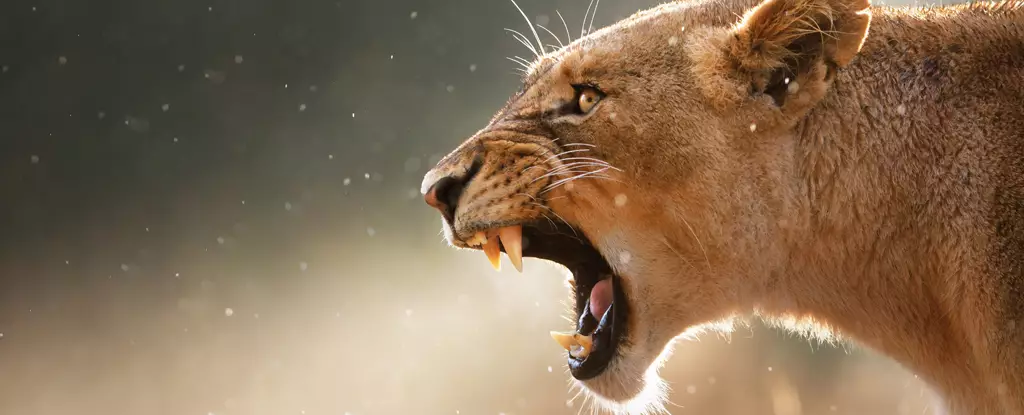In the intricate dance of life on the African savanna, one might instinctively think of lions as the apex predators that reign terror over the landscape. With formidable physical attributes—muscular builds, razor-sharp claws, keen eyesight, and powerful jaws—they certainly command respect among their fellow creatures. Conservation biologist Michael Clinchy from Western University, Canada, astutely notes that lions embody the quintessential example of a group-hunting predator, instilling fear as a hunting collective. However, a surprising dynamic has emerged from recent research: the fear of humans eclipses that of even these majestic beasts. A staggering 95% of animal species observed on the savanna reacted with marked distress to human sounds, undermining the once widely held belief that lions were the ultimate source of fear.
This pervasive terror of humans is not merely an overreaction; it is an ingrained survival instinct cultivated over generations. As Clinchy aptly points out, “the fear of humans is ingrained and pervasive.” The notion that wildlife may gradually adapt to human presence—thus minimizing their natural instinct to flee—has been thoroughly challenged. By employing auditory experiments, ecologists led by Liana Zanette were able to capture this fear in a controlled setting, revealing that animals do not become desensitized to human presence. This lack of habituation raises moral and ethical questions about how we interact with wildlife and the looming implications of human expansion into natural habitats.
Research Insights: Sounds Speak Louder Than Actions
Conducting research in South Africa’s Greater Kruger National Park, scientists played a range of sound recordings to observe the reactions of local wildlife. The decision to include human conversations in various local languages along with the sound of hunting provided a rich context for understanding animal responses. Interestingly, while the sounds of lions communicating among themselves were included, these were less alarming to the mammals in the area. As Clinchy explains, the content being communicated mattered—calm, transactional vocalizations from lions didn’t strike the same chord of terror as human conversations did.
The data resoundingly indicated that animals from diverse species—rhinos, elephants, giraffes, hyenas, leopards, zebras, and warthogs—exhibited twice the likelihood of abandoning their water sources upon hearing human chatter compared to the sounds made by lion activity. This presents an alarming insight into animal behavior, revealing that many species, rather than viewing other natural predators as their main threats, instead perceive humans as the far greater danger. Such findings inevitably call for introspection on our role in the natural world and highlight the grave urgency for more compassionate approaches to wildlife management.
The Consequences of Fear: Impacts on Wildlife Populations
The implications of this fear stretch far beyond immediate reactions. Ongoing exposure to human sounds can have long-term consequences for wildlife populations, notably contributing to declines in species that are already vulnerable or endangered. Numerous reports indicate that fear, particularly that of human intrusion, can inhibit reproductive success and survival, creating a vicious cycle of declining populations. With dwindling numbers of iconic species such as giraffes, these nuances of ecological interaction deserve much greater attention.
The long-range impacts of continued human presence may fundamentally alter population dynamics across species and disrupt the intricate web of ecological balance inherent in these ecosystems. This research illuminates the importance of understanding not just habitat loss and climate change, but also the psychological battle that wildlife faces in an increasingly human-dominated world.
Nevertheless, there may be pathways to leverage this newfound understanding. By broadcasting human sounds in areas notorious for poaching, conservationists hope to create protective barriers for endangered species such as the Southern white rhino. “The pervasiveness of the fear throughout the savannah mammal community is a real testament to the environmental impact that humans have,” states Zanette, emphasizing that animals’ responses to human presence serve as a stark indicator of our ecological footprint.
In light of this, wildlife conservation efforts must adapt to these realities by developing innovative strategies that consider not simply habitat preservation, but also the psychological relationships animals maintain with their surroundings. As scientists deepen their understanding of fear responses in wildlife, they illuminate a pressing imperfection in our perception of ourselves as guardians of nature.
In a world where humans loom large over the ecosystem, it is high time we re-evaluate our role—not just as stewards but also as a source of anxiety for the very fabrics of life we intend to protect.

Leave a Reply